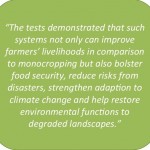
Despite clear evidence of agroforestry’s potential to address environmental degradation, food insecurity and poverty, there is no national agroforestry policy in Viet Nam. One is sorely needed, say researchers. Just as much as a strategy in tree domestication which would benefit timber supply, farmers’ livelihoods, biodiversity and environmental security. ICRAF’s Rob Finlayson explains why.
At present, agriculture and forestry are segregated conceptually in Viet Nam. And although numerous agroforestry systems have been successfully tested over the years, they have not been widely adopted. To find out why, researchers from the World Agroforestry Centre Viet Nam, with support from the Australian Centre for International Agricultural Research (ACIAR), Viet Nam’s Ministry of Agriculture and Rural Development, and the CGIAR Research Program on Forests, Trees and Agroforestry, reviewed over 50 national and provincial government policies and held 10 workshops with all stakeholders. (ACIAR is working with ICRAF to test new agroforestry systems in Northwest Viet Nam.)
 The conclusion drawn from this extensive review was that for agroforestry to be adopted by the nation’s farmers, policies are needed, particularly an overarching national policy, Finlayson writes in a recent World Agroforestry Blog.
The conclusion drawn from this extensive review was that for agroforestry to be adopted by the nation’s farmers, policies are needed, particularly an overarching national policy, Finlayson writes in a recent World Agroforestry Blog.
Much the same applies for Viet Nam’s approach to tree domestication, Finlayson argues in another blog.
Over the last 25 years, planted trees in Viet Nam have successfully restored many forest functions, however, the quality of these ‘forests’ is limited and seedling supply is often of poor quality. Improved tree domestication can concomitantly lead to improvements in nearly all aspects of the forestry value chain but a comprehensive strategy is needed rather than the current piece-meal approach, argue World Agroforestry Centre researchers in a recent policy brief, Call for a Tree Domestication Strategy In Vietnam.
‘Tree domestication’ is a term generally used to describe the selection, breeding and adaption of germplasm (seeds and seedlings) to increase production and quality. A national domestication strategy would accelerate the improvement of tree quality and quantities, particularly for indigenous species that are currently underutilised but naturally suited to Viet Nam’s nine agro-ecological zones. This would lead to subsequent improvements in farmers’ livelihoods, biodiversity and environmental security, including timber supply and food security.
The Australian Centre for International Agricultural Research , it says in a third blog.
Read more at
A national agroforestry policy is an imperative for Viet Nam
Viet Nam needs a tree-domestication strategy











